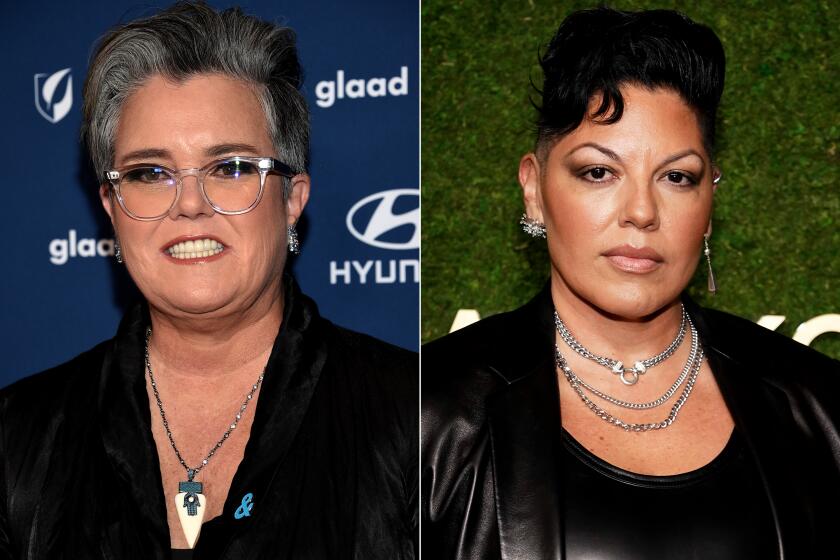A middle-class drama
You’ve probably never heard of John Eric Bentley.
But you might recognize his face. The 38-year-old actor has played a park ranger in the TV series “Bones,” a police officer in “CSI: Miami” and a judge on “Hannah Montana.”
Yet despite some 50 film and TV credits, Bentley makes barely enough to support his four children and pay the mortgage on his West Hills home. He recently began a graveyard shift as a security guard at a Marriott Hotel to supplement his acting income, which swings between $50,000 and $150,000 a year.
“I’m in a survival mode,” Bentley said. “Every day is a fight.”
Bentley is a journeyman actor working in the shadow of multimillionaire stars -- a member of Hollywood’s “middle class,” whose economic plight is a flash point in the difficult negotiations between studios and the Screen Actors Guild. Talks are expected to resume today.
These actors contend that over the last decade they’ve been squeezed out of roles by the proliferation of reality shows and that their paychecks have shrunk because of dwindling residuals from fewer reruns. Nor are cost-conscious producers willing any longer to routinely pay actors their “quote,” a fee based on experience.
Middle-class film and TV actors -- defined by SAG as those who earn enough to qualify for the union’s health insurance but less than $100,000 a year -- are hardly representative: They account for less than 5% of the guild’s 122,000 members.
Nonetheless, this sliver plays an outsize role within the union because the vast majority of members don’t, in fact, earn a livelihood from acting. “If we can’t reverse the trends for working-class actors, we’ll cease to exist,” said SAG President Alan Rosenberg. “We’ll be hobbyists.”
Guild leaders have sought substantial increases in pay for such actors, guarantees that they will be better compensated when their shows are distributed online and hikes in a decades-old residuals formula for DVD sales. They cite SAG-compiled statistics showing that average earnings for middle-class actors adjusted for inflation fell 16% to $52,000 a year between 2001 and 2007. By comparison, median income for U.S. households remained virtually flat over much of the same period, declining less than 1% to $49,830 between 2001 and 2006, the last year for which data are available, according to the U.S. Census Bureau.
Such arguments haven’t budged the studios, which have balked at what they describe as the union’s “unreasonable demands” in both traditional and new media. Studios contend that they’re grappling with higher marketing and production costs -- partly driven by the rising salaries of stars -- as well as falling DVD sales and the loss of younger viewers, who are turning to the Internet for their entertainment.
“SAG’s proposals would add enormous costs to scripted series, diminishing job opportunities for their members and making it less attractive for our companies to produce these shows,” said Jesse Hiestand, spokesman for the Alliance of Motion Picture and Television Producers, which negotiates on behalf of the studios. “This is happening in an environment where both of us are facing the same challenges.”
Of course, acting has always been a risky, itinerant business, exposing artists to cycles of feast or famine -- no parent ever suggested acting as a backup career. But working actors contend that fallow periods have grown longer in recent years for various reasons.
Networks now depend much more heavily on reality TV programs, which do not require actors, to fill their schedules. That’s hurt actors like Bentley, for whom roles on sitcoms such as “Martin” and “Sister, Sister” were once his bread and butter.
What’s more, guest-star TV roles, once a mainstay of middle-class actors, now often go to movie stars, such as Robin Williams in “Law & Order: Special Victims Unit,” Lindsay Lohan in “Ugly Betty” and Stanley Tucci, who had a recurring role last season as a doctor on “ER.”
The growth in cable TV has created opportunities for actors, but those shows generally pay much less than network television.
With fewer shows repeating on the networks or sold into syndication, actors have also seen a steady erosion in their income from residuals, the extra fees they receive from reruns. Actors earn as much as half their income from residuals. Increasingly, networks stream reruns on the Web free, without paying actors residuals (the studios have proposed to actors a pay structure for streaming).
The biggest beef among actors, however, is that producers typically offer them only the union’s minimum rate, known as “scale plus 10,” base pay plus 10% commission for their agents. That’s a change from the past, when actors could negotiate a fee that better reflected their experience in front of the camera.
The current minimum wage for a speaking role is $759 a day and $2,634 a week. Moreover, acting fees for TV pilots are in some cases half what they were a decade ago.
It is a conversation stopper for actors.
Getting ready to make their case to the studios on the opening day of SAG negotiations last month, actress Lisa Ann Walter recalled standing with some fellow actors, including Frances Fisher and Laura Dern, commiserating about the diminishing pay for guest stars. Walter, whose credits include the nanny in Disney’s 1998 remake “The Parent Trap,” said guest stars who used to receive a “top of show” weekly rate instead are often paid scale for just one or two days’ work.
“I have this recurring nightmare that I’m standing there filling someone’s coffee cup and they say, ‘Your voice sounds familiar. Weren’t you the nanny in ‘The Parent Trap?’ ” said Walter, a divorced mother raising four children in Sherman Oaks.
Other actors say they too are pedaling backward economically.
Despite a long list of credits, veteran film and TV actor Brett Cullen says he rarely gets more than scale these days. In 2006, he was paid about $6,200 per episode for his recurring role as Gov. Ray Sullivan in “The West Wing,” about half what he earned in 1994 when he was a guest star in one episode of “Matlock.”
“There are so many people who want the job, they can say, ‘Hey, we love Brett; if he doesn’t want to do it at this price, we’ll find someone else,’ ” he said.
In such lean times, many actors rely on commercials and voice-over work. Others go to great lengths -- literally -- even just for the promise of a film or TV job. Mike Pniewski, who lives in Atlanta, recently flew more than 400 miles each way to New Orleans for a callback audition for a Lifetime television movie. The following day he drove four hours to Charlotte, N.C., for one day’s work on an independent film.
“The opportunities aren’t what they used to be, and I’m making less per job,” said the 47-year-old father of three who has appeared in shows including “Law & Order” and the movie “We Are Marshall.” “So you can’t necessarily pass up any opportunity to work.”
Some actors have found inventive ways to keep working.
Ten years ago, Gary Hudson, who lives in a rent-controlled apartment in Santa Monica, concluded that with so much production fleeing to Canada, he needed to apply for dual citizenship to help win roles that otherwise might have gone to Canadian actors. Tax incentives in Canada require producers to hire a minimum number of native crew members. Since then, the 52-year-old Hudson, born in Virginia, landed roles in a number of TV shows shot in Canada, including “Smallville.”
“I decided that if I don’t do this, I’m going to be waiting tables in Santa Monica,” Hudson said. He recently won a lead role in a drama about the oil industry -- on Canada’s CBC.
--
claudia.eller@latimes.com
More to Read
The biggest entertainment stories
Get our big stories about Hollywood, film, television, music, arts, culture and more right in your inbox as soon as they publish.
You may occasionally receive promotional content from the Los Angeles Times.







